Discover 35 hidden attractions, cool sights, and unusual things to do in Arlington (United States). Don't miss out on these must-see attractions: Old Schwamb Mill, Calvary Methodist Church, and Cyrus Dallin Art Museum. Also, be sure to include Spy Pond in your itinerary.
Below, you can find the list of the most amazing places you should visit in Arlington (Massachusetts).
Table of Contents
Old Schwamb Mill
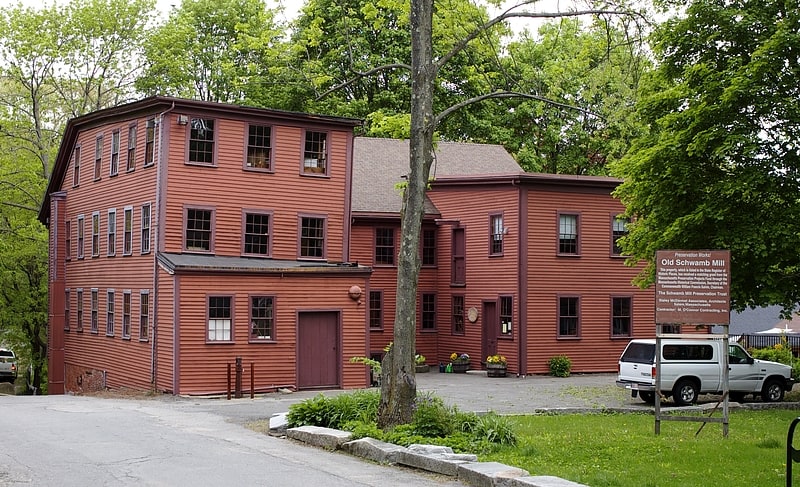
Museum in Arlington, Massachusetts. The Old Schwamb Mill is an historic 19th-century mill at 17 Mill Lane in Arlington, Massachusetts. It claims to be located on the oldest continuously-used mill site in the United States, with a documented history of operation dating back to about 1684. The current mill building, erected in 1861, is now a living history museum. The property was listed on the National Register of Historic Places in 1971.[1]
Address: 17 Mill Ln, 02476-4189 Arlington (Arlington)
Calvary Methodist Church
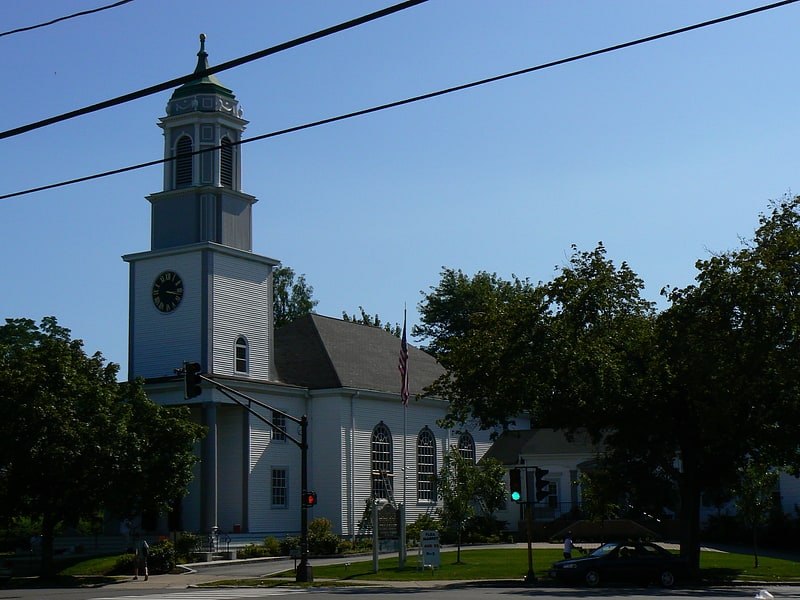
Church building in Arlington, Massachusetts. Calvary Methodist Church is a historic Methodist church building at 300 Massachusetts Avenue in Arlington, Massachusetts. Built in 1919-23, the building is a near replica of Boston's Kings Chapel, executed in wood. Its tower is topped by a belfry designed by architect Charles Bulfinch in 1809 and built for use on Boylston Market; it was rescued from demolition and given to the church in 1921. The building was listed on the National Register of Historic Places in 1983.[2]
Address: 300 Massachusetts Ave, 02474-8301 Arlington (Arlington)
Cyrus Dallin Art Museum
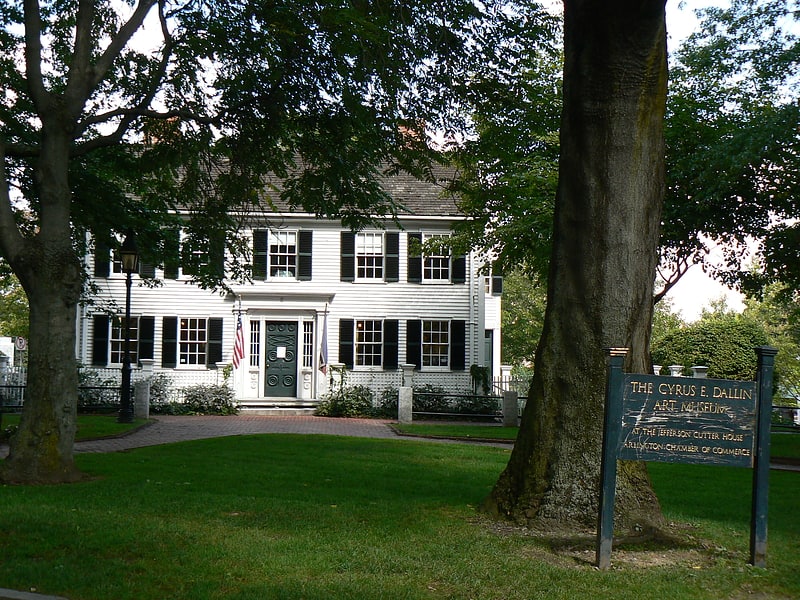
Museum. The Cyrus Dallin Art Museum in Arlington, Massachusetts, United States is dedicated to displaying the artworks and documentation of American sculptor, educator, and Indigenous rights activist Cyrus Dallin, who lived and worked in the town for over 40 years. He is best known for his iconic Appeal to the Great Spirit and Paul Revere Monument statues, both located in Boston.[3]
Address: 611 Massachusetts Ave, 02474-5103 Arlington (Arlington)
Spy Pond
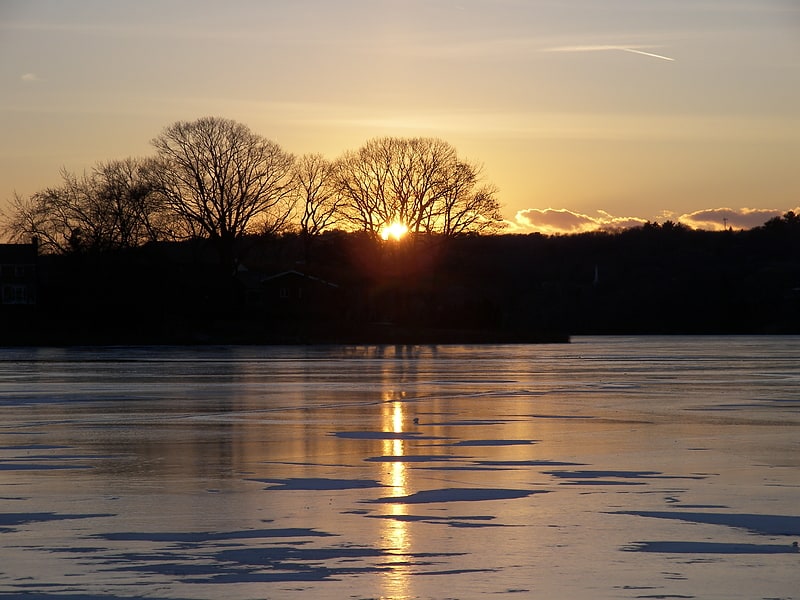
Pond in Massachusetts. Spy Pond, also known as Spie Pond in the 17th & 18th centuries, is a 103-acre kettle hole pond located near the heart of Arlington, Massachusetts, adjacent to the Minuteman Bikeway.[4]
Jason Russell House

Museum in Arlington, Massachusetts. The Jason Russell House is a historic house in Arlington, Massachusetts, the site of the bloodiest fighting on the first day of the American Revolutionary War, April 19, 1775. The house was purchased in 1923 by the Arlington Historical Society which restored it in 1926, and now operates it as a museum from mid-April through the end of September, together with the adjoining Smith Museum, built in 1981 to house changing exhibitions of life in Arlington.[5]
Address: 7 Jason St, 02476 Arlington (Arlington)
Uncle Sam Memorial Statue

Statue by Theodore Cotillo Barbarossa. The Uncle Sam Memorial Statue is a statue commemorating Samuel Wilson, perhaps the original Uncle Sam, near his birthplace in the center of Arlington, Massachusetts, United States. It was sculpted by Theodore Cotillo Barbarossa. It is located on Mystic Street, across from the Cyrus Dallin Art Museum, and adjacent to the Minuteman Bikeway.
The sculpture is a bronze relief of Uncle Sam and three-dimensional sculpture of Samuel Wilson, installed on a limestone base in front of a wall rising from the base's rear. It was funded by Frederick A. Hauck of Cincinnati, Ohio, cast in 1976, installed during the United States Bicentennial on September 11, 1976, and dedicated April 18, 1977.
The bronze relief depicts the life and work of Samuel Wilson in Troy, New York and Mason, New Hampshire, and in Menotomy, Massachusetts. The relief includes a depiction of the familiar image of the elderly "Uncle Sam" figure in top hat and tails. At its top is a butcher and a ship coming in to dock next to the word "TROY"; in the middle is a pioneer couple standing behind a fence with the words "MASON N-H"; and at the bottom is a soldier on horseback above the word "MENOTOMY." To the relief's right is a standing portrait of Wilson carrying his top hat in the crook of his left arm and extending his right hand slightly.
The sculpture is approximately 8 feet, 8 inches high, on a base approximately 15 feet, 8 inches high by 10 feet wide. Its weight is 17 tons. It was cast and erected by Eleftherios Karkadoulias, with stone work fabricated by Woolery Stone Company, and contains a number of inscriptions, including:
- Base, front above sculpture: SAMUEL WILSON / 1766-1854
- Base, front below figure: IN HONOR OF SAMUEL WILSON / A NATIVE SON / BORN NEAR THIS SITE / ON SEPTEMBER 13, 1766 / HE BECAME / OUR NATIONAL SYMBOL / UNCLE SAM
- Base, bronze plaque on side of base: UNVEILED / SEPTEMBER / 11-1976 / DEDICATED / APRIL-18, 1977 / FREDERICK A. HAUCK / A GIFT TO THE TOWN OF ARLINGTON / MASS. AND THE PEOPLE OF THE UNITED STATES THROUGH THE GENEROUS / CONTRIBUTION OF FREDERICK A. HAUCK / OF CINCINNATI, OHIO / DESIGNER-SCULPTOR T.C. BARBAROSSA / BELMONT, MASS. / CAST BY ELEFTHERIOS KARKADOULIAS / CINCINNATI, OHIO / PROJECT COORDINATOR / THE ARLINGTON JAYCEES / BOARD OF SELECTMEN / ARTHUR D. SAUL, JR. CHAIRMAN / ROBERT B. WALSH / ANN MAHON POWERS / MARGARET H. SPENGLER / ROBERT H. MURRAY / TOWN MANAGER / DONALD R. MARQUIS / UNCLE SAM STATUE COMMITTEE / WILLIAM J. BECK / JACK R. DONALSON / JAMES D. HOBBS / JAMES F. LAWSON, JR. / STEPHEN PEKICH / FREDERICK E. PITCHER / JOHN G. PERRY / WILLIAM J. SCAGLIONE.
Arlington Reservoir
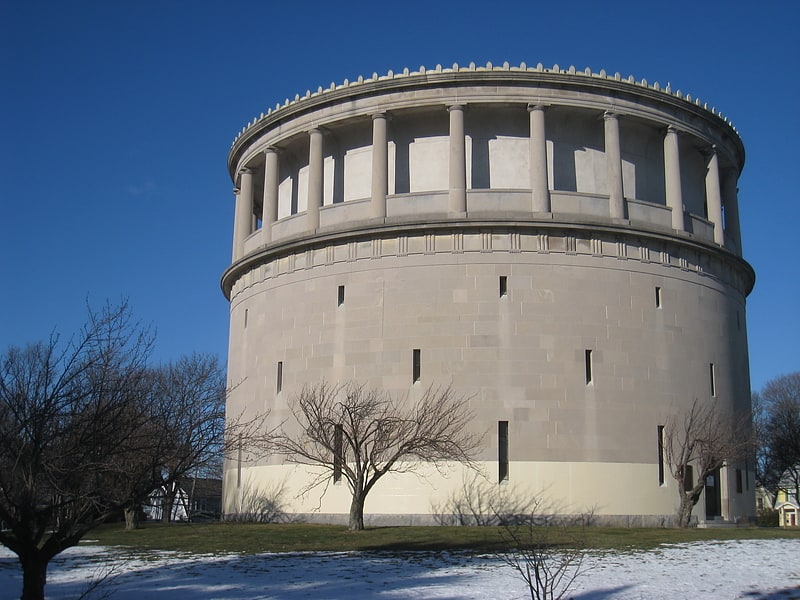
Park in Arlington, Massachusetts. The Arlington Reservoir is a large water storage tank located on Park Circle in Arlington, Massachusetts. It was constructed by the Metropolitan Water Works between 1921 and 1924 in the Classical Revival style, to provide water storage for Northern Extra-High Service area, consisting of Lexington and the higher elevations of Belmont and Arlington.
It was added to the National Register of Historic Places in 1985.[7]
Baptist Society Meeting House
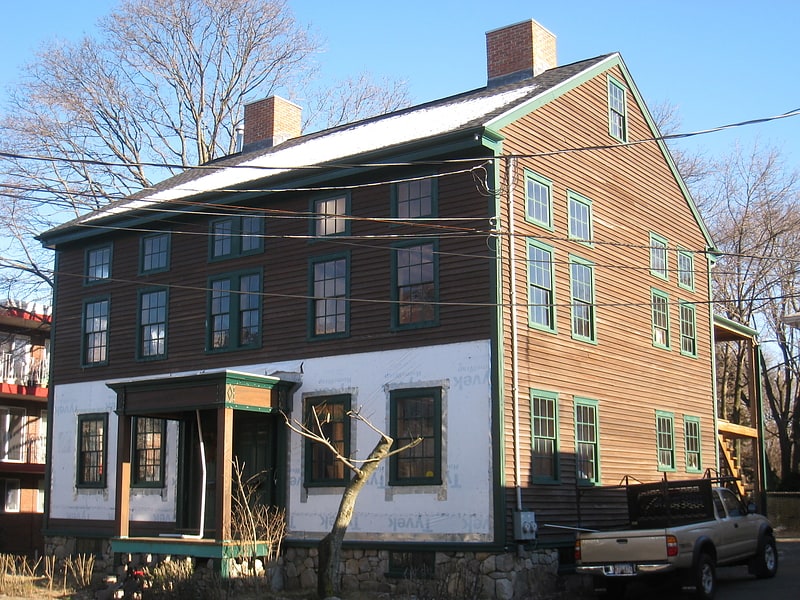
Building. The Baptist Society Meeting House is a historic former Baptist meeting house in Arlington, Massachusetts. Built in 1790, it is the town's oldest surviving church building. Now in residential use, the building was listed on the National Register of Historic Places in 1985.[8]
Address: 3 Brattle Street, Arlington (Arlington)
Goddard Hall
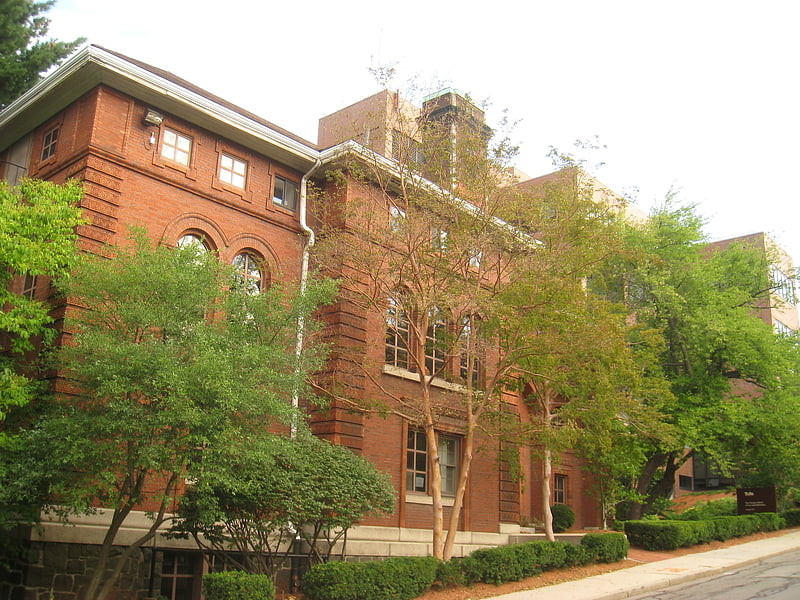
Goddard Hall, originally known as Goddard Gymnasium, is a historic academic building on the campus of Tufts University in Medford, Massachusetts. Built in 1883 and designed by George Albert Clough, it was originally built to serve Tufts students as a gymnasium. In 1892, the building was remodeled and in 1930, the building was handed over to the Fletcher School of Law and Diplomacy for use as a library.[9]
Address: 160 Packard Avenue, Arlington (Somerville)
Tisch Library
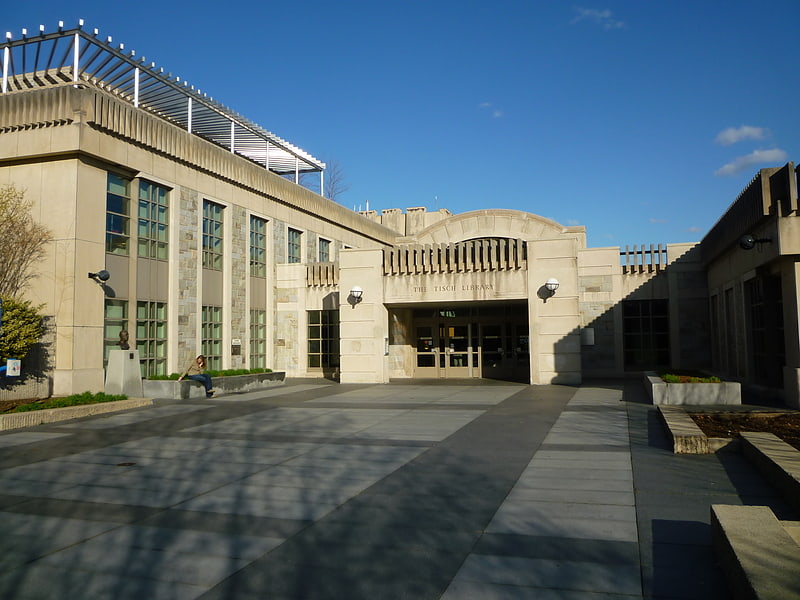
University library in Somerville, Massachusetts. Tisch Library, originally Wessell Library, is the principal library for the Medford/Somerville campus of Tufts University.[10]
Address: 35 Professors Row, Arlington (Somerville)
Capitol Theater Building
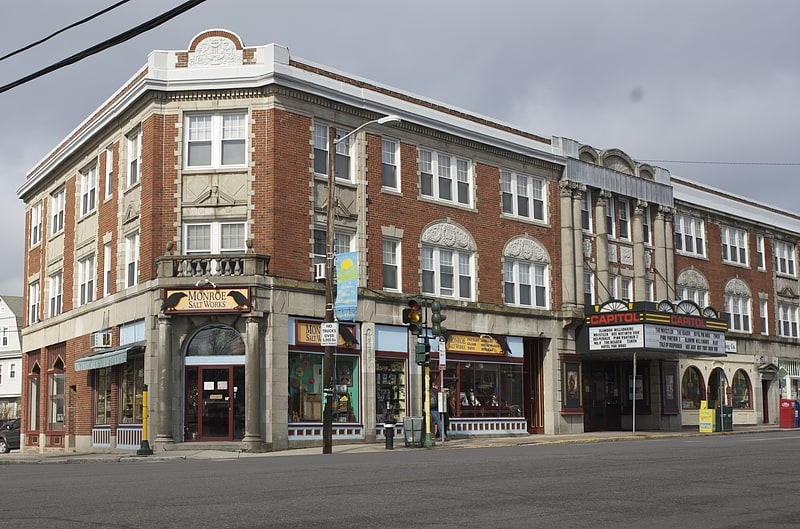
Theater in Arlington, Massachusetts. The Capitol Theater Building is a historic mixed commercial, residential, and theatrical building at 202–208 Massachusetts Avenue in Arlington, Massachusetts. It was built in 1925 by the Locatelli family, and is one of the area's finest early motion picture theaters. The building was added to the National Register of Historic Places in 1985.[11]
Address: 204 Massachusetts Ave, 02474-8403 Arlington (Arlington)
Highrock Church
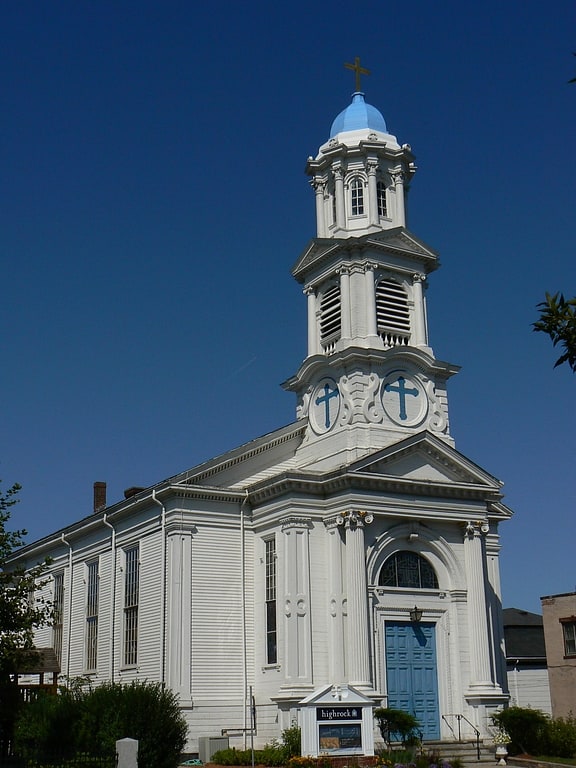
Church in Arlington, Massachusetts. Highrock Church is an Evangelical Covenant Church congregation located in Arlington, Massachusetts. Founded in 1999, it occupies the former Saint Athanasius Greek Orthodox Church at 735 Massachusetts Avenue in the town center. The building, constructed in 1841 and restyled in 1860, is a prominent regional example of Italianate ecclesiastical architecture, and was listed on the National Register of Historic Places in 1983.[12]
Address: 735 Massachusetts Ave, 02476 Arlington (Arlington)
Prince Hall Mystic Cemetery

Cemetery in Arlington, Massachusetts. The Prince Hall Mystic Cemetery, also known as the Prince Hall Cemetery, is a historic cemetery located on Gardner Street, Arlington, Massachusetts. It is said to be the only remaining African American Masonic cemetery in the United States.
The cemetery is a burial place for members of the Prince Hall Grand Lodge F & AM, founded by Prince Hall in Boston in 1776. Prince Hall Freemasonry was the first African American Masonic group in the United States. In 1864, Grand Master William B. Kendall deeded this site to his lodge. The cemetery was dedicated in 1868, and put in trust to be used exclusively as a Prince Hall Freemasonry burial ground. Records indicate it was in use until about 1897 when it fell into disuse.
As time passed it was forgotten until its rediscovery in 1987. It was rededicated in 1990, and added to the National Register of Historic Places in 1998. Today the cemetery is the last extant cemetery associated with Prince Hall Masons. It contains a small park with a monument. A 1988 survey found remains of the original gate and an obelisk.[13]
Packard Hall

Packard Hall, originally known as Middle Hall is a historic academic building on the campus of Tufts University in Medford, Massachusetts. Built in 1856, it was Tufts' second building constructed on Walnut Hill following Ballou Hall in 1852. The building currently houses the Department of Political Science.[14]
Address: 175 Packard Avenue, Arlington (Somerville)
First Parish Church
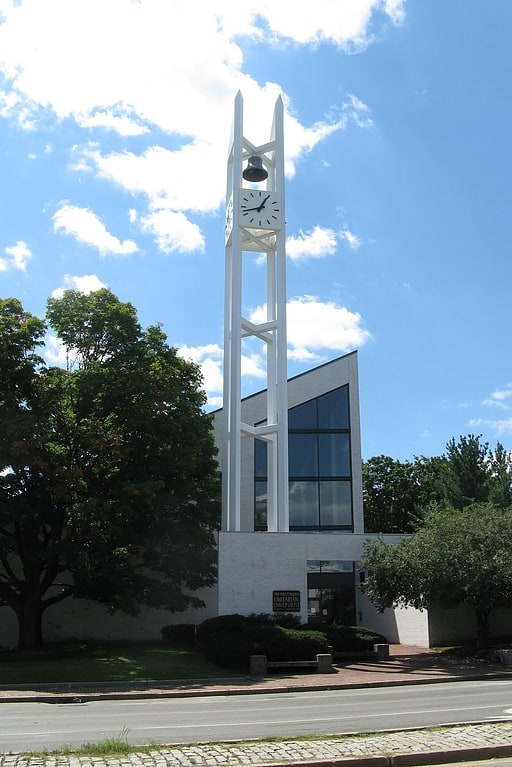
Unitarian universalist church in Arlington, Massachusetts. First Parish Church in Arlington, Massachusetts is a Unitarian-Universalist congregation, which was founded in 1678 as First Parish in West Cambridge. It merged with the Arlington Universalist Congregation in 1962. The Highrock Church building originally housed the Universalist church in Arlington, one of the congregations joined in 1961 with the formation of the Unitarian Universalist Association, with the Unitarian congregation at the corner of Pleasant and Massachusetts Avenue.[15]
Address: 630 Massachusetts Ave, 02476-5003 Arlington (Arlington)
Walnut Hill
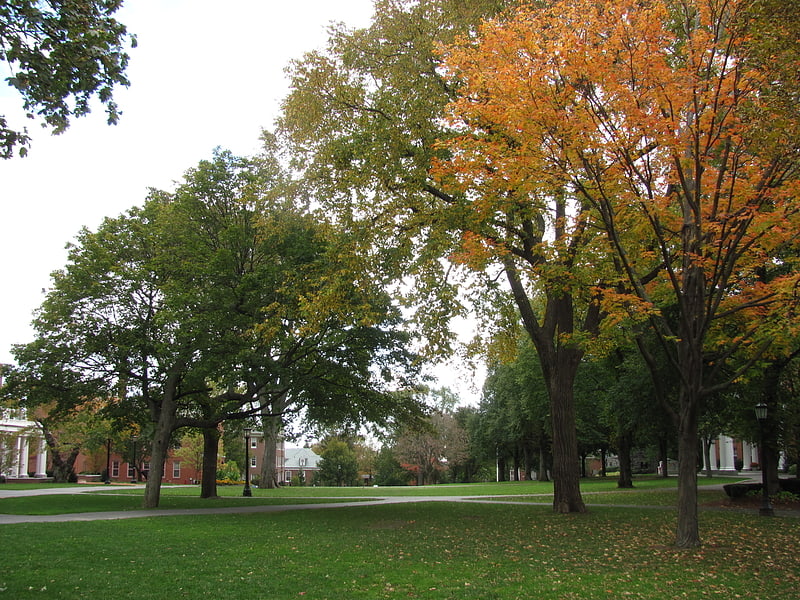
Walnut Hill, located in Medford, Massachusetts, is the geographical home of Tufts University. Walnut Hill itself later became known as College Hill due to the dominant presence of the University.[16]
Walden Street Cattle Pass
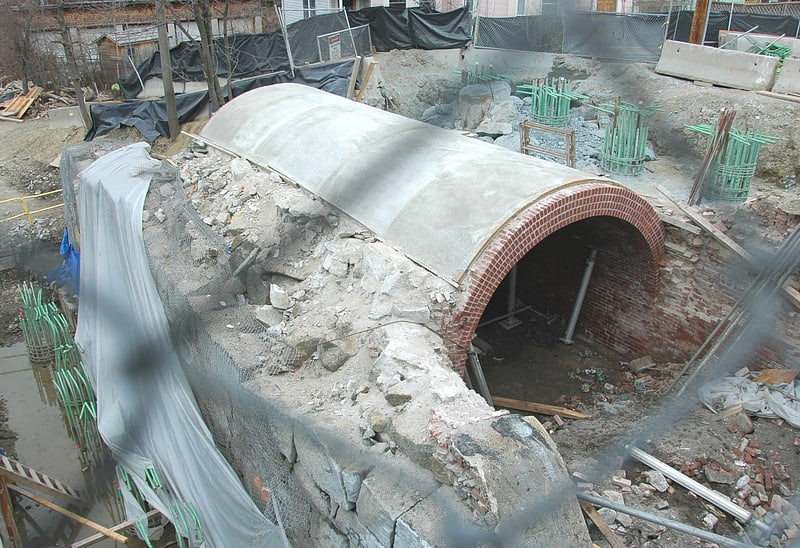
The Walden Street Cattle Pass, also referred to as the cow path, is an historic site adjacent to the MBTA Commuter Rail Fitchburg Line right-of-way, under the Walden Street Bridge in Cambridge, Massachusetts. It was added to the National Register of Historic Places in 1994.
The site, a tunnel for moving cattle between the railroad and the nearby stockyards of the 19th century, was built in 1857. The cattle yards were closed in 1868 or "about 1871", but the cattle trade continued; "until the 1920s, cows were unloaded here and driven down Massachusetts Avenue, through Harvard Square, and across the river to the Brighton Abattoir".
Restoration (re-pointing) of the tunnel's brickwork was carried out during the 2007–08 replacement of the second-generation bridge dating from 1914. The third-generation bridge opened for traffic in December 2008. The Cambridge City Council discussed creation of a vantage point for viewing the tunnel, ca. 2008, but no action was taken.[17]
House at 25 Clyde Street

The House at 25 Clyde Street in Somerville, Massachusetts is an example of a vernacular brickworker's house in the area. It is estimated to have been built about 1850, when the area was near one of the city's many brickyards. One characteristic common to these houses was the high brick basement wall, which is visible in this house.
The house was listed on the National Register of Historic Places in 1989.
By May 2014, the house was partially demolished, renovated and converted into a 3-unit condo. The entire shed in the back yard was demolished.[18]
Walter Frost House

The Walter Frost House is an historic house at 10 Frost Street in Cambridge, Massachusetts. The three story wood-frame house was built in 1807, and was originally located on Massachusetts Avenue. The Federal style house was moved to its present location in 1866 to make way for the North Avenue Congregational Church, which was moved to its site.
The house was listed on the National Register of Historic Places in 1982.[19]
Friends of Robbins Farm Park

Playground, Park, Relax in park
Address: 51 Eastern Ave, 02476 Arlington (Arlington)
Grandfather's House
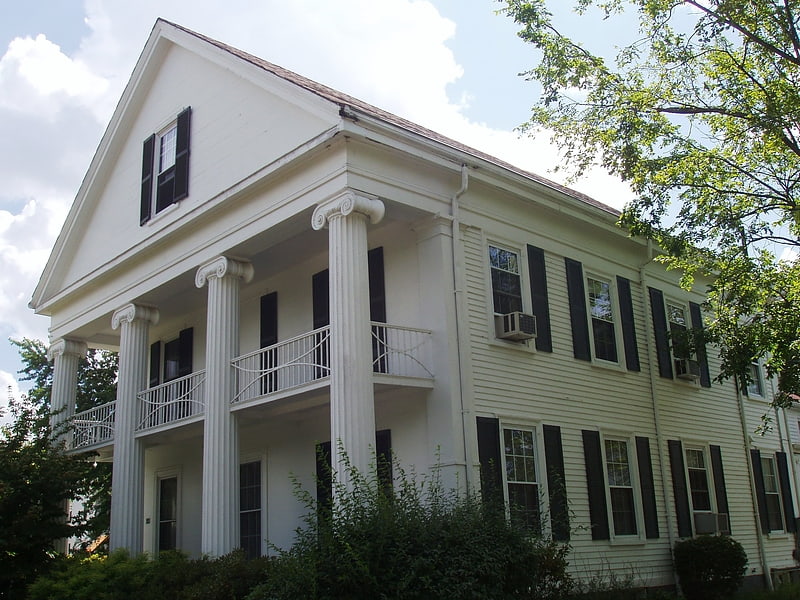
Grandfather's House, also known as the Paul Curtis House, is a historic house in Medford, Massachusetts. It is claimed to be the original house named in the American poem "Over the River and through the Wood" by Lydia Maria Child.
The house, which was listed on the National Register of Historic Places in 1975, is also noteworthy for being the best preserved example of Greek Revival architecture in Medford, and for its association with Paul Curtis, a prominent local shipbuilder.
The rear portion of the modern house was built as a small farmhouse in the early 19th century. Child recalled the farmhouse when she wrote of her childhood visits to her grandfather's house in her poem, published in 1844. The house is located near the Mystic River, which is believed to be the river referred to in the poem. The referenced woods have long since been replaced by residential housing.
About 1839, Curtis greatly enlarged the house and gave it its two-story Ionic portico. In 1975, the house was added to the National Register of Historic Places. In 1976, Tufts University purchased and restored the house. In 2013 the house was sold to a developer who divided the lot the house sits on in order to build a duplex next door. In 2014 the house was again sold without its former yard to a private individual.
In the 19th century, ships were built across the street. A painting hung in the house shows a ship being built, with the house across the river, and Ballou Hall (the original Tufts building) on top of the hill in the distance, with no other development in between.[20]
North Cambridge

Neighborhood in Middlesex County, Massachusetts. North Cambridge, also known as "Area 11", is a neighborhood of Cambridge, Massachusetts bounded by Porter Square and the Fitchburg Line railroad tracks on the south, the city of Somerville on the northeast, Alewife Brook and the town of Arlington on the northwest, and the town of Belmont on the west. In 2005 it had a population of 10,642 residents living in 4,699 households, and the average income was $44,784. In 2010, the racial demographics for the neighborhood were 57.6% White, 20% Black, 15.1% Asian/Pacific Islander, 7.3% Hispanic origin, 0.3% Native American, 2.4% other race.
The main commercial areas of North Cambridge are situated along Alewife Brook Parkway and Massachusetts Avenue. A third area, Davis Square, in Somerville, also exerts considerable influence on the North Cambridge neighborhood.
Four roads span the railroad tracks, connecting the bulk of North Cambridge with other neighborhoods of Cambridge. From east to west, these are: Mass. Ave. (route MA-2A), Walden Street, Sherman Street (grade crossing), and Alewife Brook Parkway (carrying routes MA-2, MA-16, and US-3).[21]
Rindge Towers
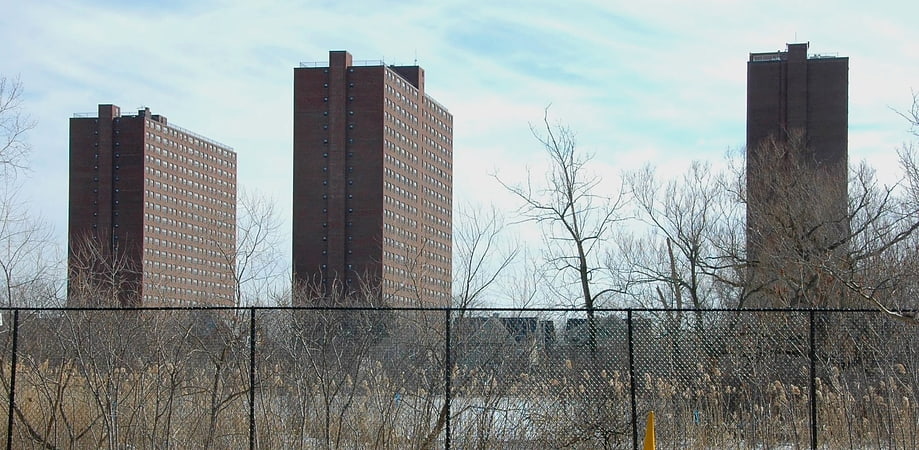
Rindge Towers is an affordable housing development in Cambridge, Massachusetts. Completed in 1970, the three 22-story towers make up a 777-unit apartment complex located in close proximity to the Alewife MBTA station at the terminus of the Red Line. The towers are named for Frederick H. Rindge, the philanthropist who funded construction of Cambridge Rindge and Latin School, Cambridge City Hall, and the Cambridge Public Library.
The towers are built in the Le Corbusier style, which advocated dense high-rise housing complexes set within parks and open spaces. This style has since fallen out of fashion in favor of mixed-use and mixed-income development. Also known as "Fresh Pond Apartments I, II and III", the buildings are by far the tallest in North Cambridge; their height is estimated at 269 feet (82 m).
Originally constructed to spur development in the Alewife region of Cambridge, the towers—like many high-rise housing projects of the era—quickly became associated with crime and fell into disrepair. Living conditions at the towers have improved from their nadir in the 1980s. However, the complex is still a focus for law enforcement activity, and in 2008 the Cambridge Police opened a substation at the towers.[22]
Address: 388 Rindge Avenue, Arlington (Cambridge)
Chapel of St. Anne

Chapel in Arlington, Massachusetts. The Chapel of St. Anne is a historic Episcopal chapel on Claremont Avenue in Arlington, Massachusetts. Built in 1915, it is the town's only work of the architect Ralph Adams Cram, and is a fine example of Norman Gothic architecture. The chapel was listed on the National Register of Historic Places in 1985.[23]
Pleasant Street Congregational Church

Congregational church. The Pleasant Street Congregational Church is an historic Congregational church at 75 Pleasant Street in Arlington, Massachusetts. The church was built in 1844 for a congregation that split doctrinally from the First Parish Church, whose adherents chose to become Unitarian. The church is a fine example of pattern-book Greek Revival architecture. Its steeple was toppled in 1871, and was again damaged by the New England Hurricane of 1938, necessitating steel reinforcements. The interior was restyled in the late Victorian period, and lengthened in 1883 to accommodate increased attendance. The Colonial Revival front entrance dates to the a series of alterations and repairs made after the 1938 hurricane.
The church building was listed on the National Register of Historic Places in 1983, and included in an expansion of the Arlington Center Historic District in 1985.
In 2011, the church closed and the congregation was disbanded. The Boston Church of Christ bought and renovated the building and hold services there.[24]
Henderson Carriage Repository

The Henderson Carriage Repository is a historic building at 2067-2089 Massachusetts Avenue in Cambridge, Massachusetts. Located just outside Porter Square, the five story brick building was built in 1892 by the Henderson family of carriage makers, to a design by Charles Park. The building was primarily used as a storage facility for carriages, with its upper floors holding as many as 2000. It has since been converted for use as offices and retail businesses.
The building was listed on the National Register of Historic Places in 1982.[25]
Address: 2067 Massachusetts Avenue, Arlington (Cambridge)
Mystic Water Works
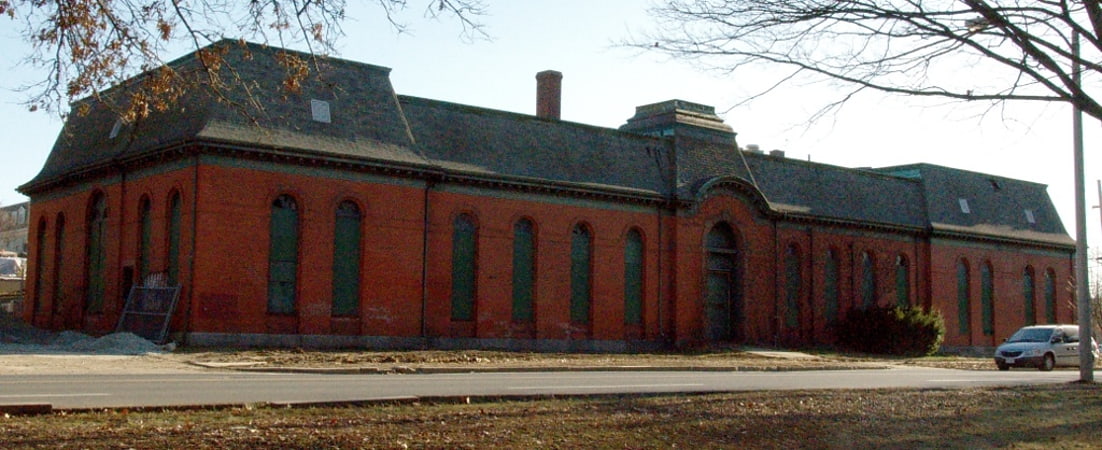
The Mystic Water Works, also called the Mystic Pumping Station, is a historic water works at Alewife Brook Parkway and Capen Street in Somerville, Massachusetts. Built in 1862–65 by the city of Charlestown, it is a significant example of a mid-19th century waterworks facility. The building has been listed twice on the National Register of Historic Places. The first, in 1989, is part of the city of Somerville's listings, and was made under the name "Mystic Water Works". The second is part of an umbrella listing covering the entire historic water works system of Greater Boston, and was made in 1990, listed as the "Mystic Pumping Station".[26]
Mystic Dam

The Mystic Dam are a historic dam and gatehouse between Lower and Upper Mystic Lakes in the suburbs north of Boston, Massachusetts. The dam was built in 1864–65 by the Charlestown Water Commission as part of a water supply system. It was located at a narrow point between the Lower and Upper Mystic Lakes, with its west end in Arlington and its east end in Medford. The water system it was a part of eventually merged into the Metropolitan District Commission, predecessor to the Massachusetts Water Resources Authority and the Massachusetts Department of Conservation and Recreation.
As built, the dam was over 1,500 feet (460 m) long and 16 feet (4.9 m) high, with most of that length (about 1,000 feet (300 m)) consisting of earthen embankments lined with riprap and puddle clay. Near its center is a spillway area consisting of a series of square columns constructed of granite blocks and a masonry apron. These columns are grooved on their inner faces to facilitate the installation of stop logs. A wooden walkway with a plank railing ran across the top of the dam. A wooden fish ladder was built, but removed at a later date. A gatehouse on the Medford side was used to connect the upper lake to a brick-lined aqueduct that delivered the water to Charlestown. The lake area impounded by the dam is 186 acres (75 ha).
The dam and gatehouse were each listed on the National Register of Historic Places in 1990. By the early 2000s, the dam was known to not be in very good condition, with failing spillway masonry, erosion, and other damage to the dam's stonework. A major storm in 2006 flooded portions of the surrounding area, and highlighted the potential inability of the dam to handle a significant high-water event, leading to catastrophic flooding of downstream areas. Between 2010 and 2012 major work was undertaken to improve the dam's condition. A new spillway was constructed to the east of the old spillway, which received a new spillway apron. Work was done on the embankments and the shores near the upper areas of the dam, and a new fish ladder and bridge were built. The historic gatehouse was also rehabilitated, and modern controls were added, enabling improved control over the water levels behind the dam.[27]
Mystic Valley Parkway

Route in Middlesex County, Massachusetts. Mystic Valley Parkway is a parkway in Arlington, Medford, Somerville, and Winchester, Massachusetts. It is listed on the National Register of Historic Places, and forms part of Route 16.[28]
Thomas Cook House
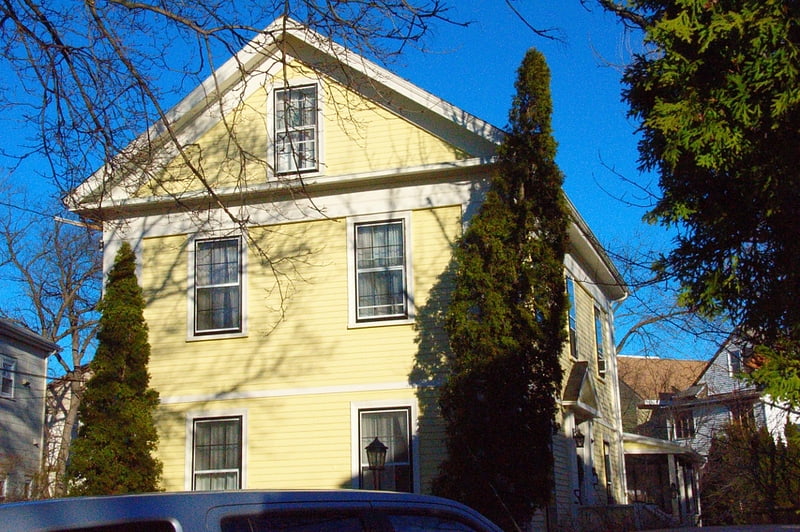
Historical landmark in Somerville, Massachusetts. The Thomas Cook House is a historic house in Somerville, Massachusetts. Built c. 1850, it is the only surviving Greek Revival farmhouse on the west side of the city, and a reminder of the area's agrarian past. It was listed on the National Register of Historic Places in 1989.[29]
Arlington Coal & Lumber
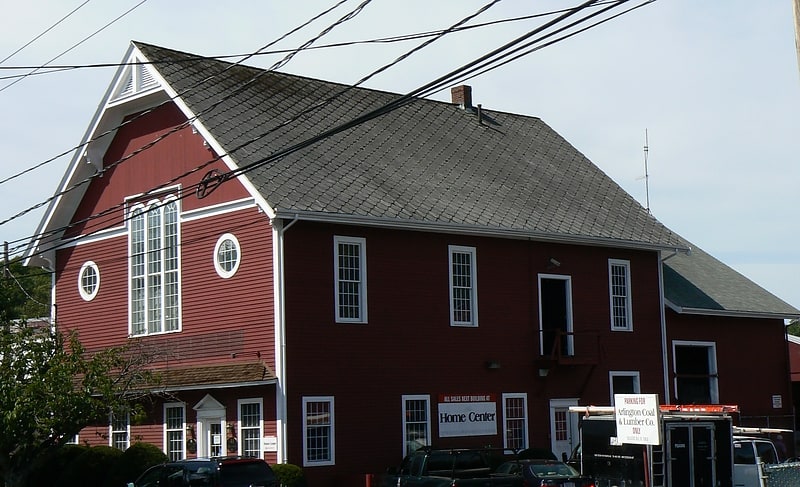
The Arlington Coal & Lumber Company building is a historic commercial and civic building in Arlington, Massachusetts. Built about 1875, it is a locally significant example of Late Gothic Revival architecture, with a long history as a community center. The building was listed on the National Register of Historic Places in 1985.[30]
Stillman Willis House
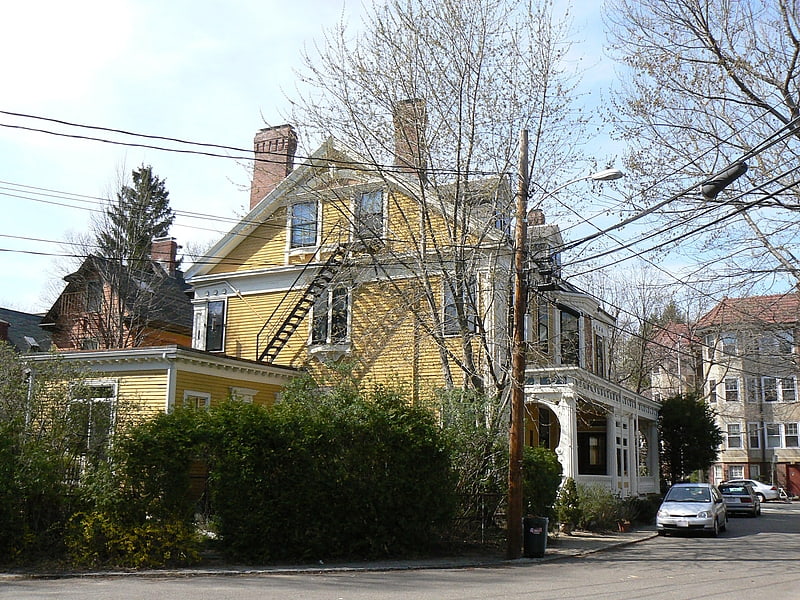
The Stillman Willis House is an historic house in Cambridge, Massachusetts. This 2+1⁄2-story house was built in 1839, and was originally located nearby on Massachusetts Avenue. It was moved to its present location in 1883, at which time it was extensively modernized, overlaying its Greek Revival features with Italianate and Colonial Revival styling. Surviving Greek Revival elements include corner pilasters and an entablature, while later features include bracketed window cornices and extensive decorative woodwork on the porches.
The house was listed on the National Register of Historic Places in 1982.[31]
House at 343 Highland Avenue

The house at 343 Highland Avenue is a historic two-family house in Somerville, Massachusetts. The 2.5-story wood-frame Queen Anne style house was built c. 1880 as commuter housing. The house features jigsaw-cut bargeboard decoration on the porches, and paired brackets in the eaves and gables. It was built on land that had been part of a brickyard, which was subdivided for development in the 1870s.
The house was listed on the National Register of Historic Places in 1989.[32]
Isaac McLean House
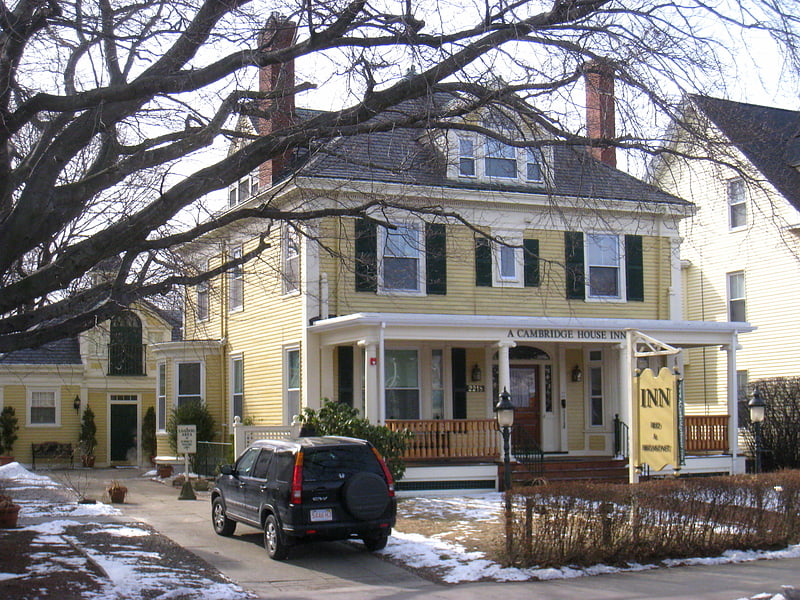
Isaac McLean House is an historic house at 2218 Massachusetts Avenue in Cambridge, Massachusetts. The house was built in 1894 and added to the National Register of Historic Places in 1982.
In 1894, Isaac McLean (a well-known Boston Accountant) engaged architects Hartwell and Richardson, and the 2218 Massachusetts Avenue (then known as North Avenue) property was built for his residence. The house was built on one of the lots then known as the Farwell Estate. A well-maintained Colonial Revival (one of the two dominant architectural styles during 1870–1920; the other being the Tudor Revival) graced by a wide porch across the entire front with classic fanlight (or transom) above the main entrance, as well as sidelights. One cannot help but notice the handsome pillars with Ionic capitals and ornamental balustrade as well as the dentils under the cornice, typical of this era. The Isaac McLean House, has been known for over 25 years as A Cambridge House Inn. This property, together with a handful of other Victorian homes represents architecture of historical significance. "This grouping of houses represents the sole remnant of what Massachusetts Avenue once was, the most prestigious Cambridge address for mid to late nineteenth century residential construction."[33]
Lovell Block
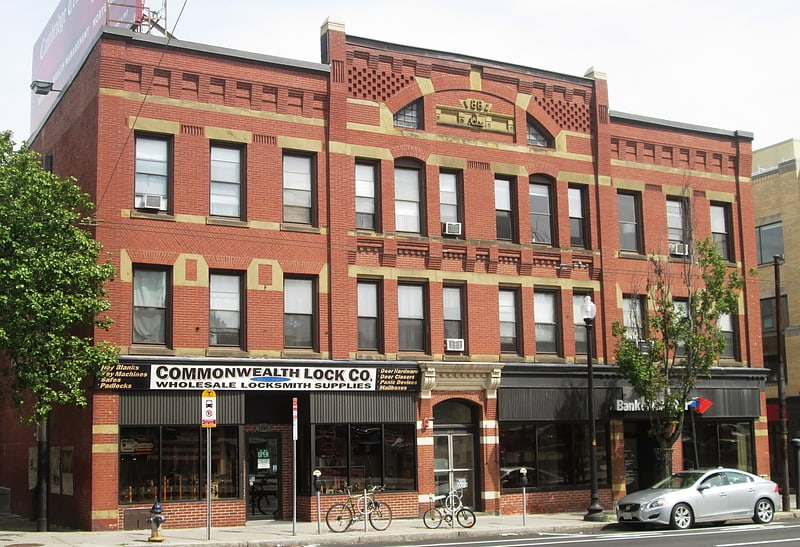
Building in Cambridge, Massachusetts. The Lovell Block is an historic residential and commercial building at 1853 Massachusetts Avenue in Cambridge, Massachusetts. The three story brick building was built in 1882 by Andrew Jackson Lovell, with two specific commercial tenants in mind. One was his own grocery business, and the other was the North Cambridge Post Office. The upper floors contained a total of four well-appointed residential flats. The building was an early instance of a mixed-use residential-commercial structure, at a time when most lower-income housing was tenement-style, and the idea of higher-quality residential rental property was relatively new.
The block was listed on the National Register of Historic Places in 1983.[34]